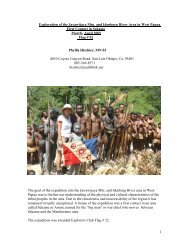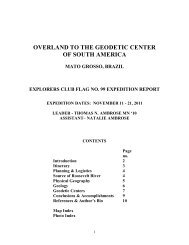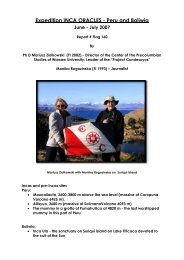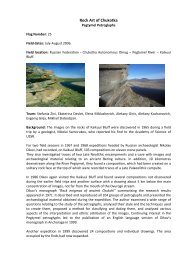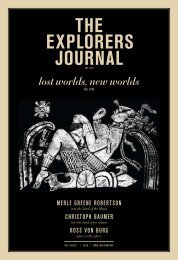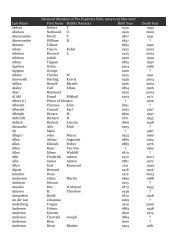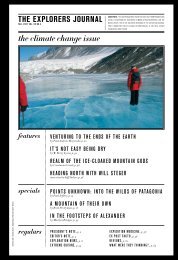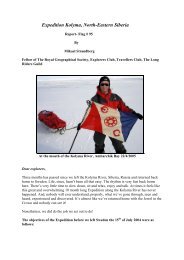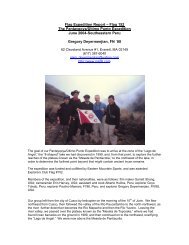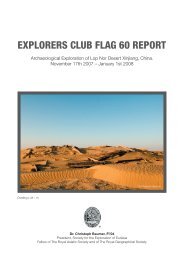the explorers journal the global adventure issue - The Explorers Club
the explorers journal the global adventure issue - The Explorers Club
the explorers journal the global adventure issue - The Explorers Club
- No tags were found...
You also want an ePaper? Increase the reach of your titles
YUMPU automatically turns print PDFs into web optimized ePapers that Google loves.
Ex Post Factotales from <strong>The</strong> <strong>Explorers</strong> <strong>Club</strong> archivesmeteoritesin Manhattanby Clare Flemming, M.S.When polar explorer John Ross returned fromhis 1818 expedition along <strong>the</strong> Greenland coast,he mentioned that <strong>the</strong> local Inuit had tools ofiron, <strong>the</strong> source of which he had not been ableto locate. He surmised that, when found, <strong>the</strong> ironwould prove to be meteoric in origin. Althougho<strong>the</strong>rs sought <strong>the</strong> elusive metal, one determinedAmerican polar explorer was able to find it:Robert Edwin Peary (1856-1920). In a slightlyimmodest phrase, Peary reported to <strong>the</strong> world,“It was fortunately reserved for me to settle <strong>the</strong>question finally and definitely,” which he did atCape York at 72°N.<strong>The</strong>re he found three meteorites that, accordingto traditional Inuit lore, were referred to as awoman, her dog, and her tent. How did Pearymanage to find what o<strong>the</strong>rs sought? Peary simplytraded a rifle for <strong>the</strong> privileged information.Two summer expeditions in 1896 and 1897 wererequired to excavate and extract <strong>the</strong> meteorites,each of which weighed several tons. Peary transported<strong>the</strong>m to Manhattan, selling all three to <strong>the</strong>American Museum of Natural History (AMNH).<strong>The</strong>se meteorites had been <strong>the</strong> sole source of62metal for <strong>the</strong> people of Cape York in an o<strong>the</strong>rwiseStone Age society, until first contact with Europeanand American whalers and sealers allowed a scanttrade in knives and o<strong>the</strong>r metal bits.As usual, Peary’s Cape York team included hisindispensable assistant Mat<strong>the</strong>w Henson andexpedition artist, Albert Operti. Operti recorded<strong>the</strong> events in one of <strong>the</strong> most beautiful paintingson display at <strong>The</strong> <strong>Explorers</strong> <strong>Club</strong>, Cape YorkGreenland Eskimos Breaking Pieces of Meteoritefor Knives, which depicts a group of Inuit painstakinglybreaking away sharp fragments of iron foruse as blades for <strong>the</strong>ir saviksue (knives).A faint penciled remark at <strong>the</strong> bottom of <strong>the</strong> paintingstates that <strong>the</strong> sketch was made “on <strong>the</strong> spotfrom a piece of Admiral Peary’s work apron 1896.”Visitors to <strong>the</strong> AMNH today can see and touch<strong>the</strong> celestial bodies, which are on view in <strong>the</strong>Arthur Ross Hall of Meteorites.Peary wrote of his claiming, extracting, removing,and selling <strong>the</strong>se ancient meteorites, “MyEskimo allies…never interposed <strong>the</strong> slightest objectionto my removal of <strong>the</strong>ir heavenly guests.”One wonders, did <strong>the</strong>y have a choice?Photo by Craig Chesek for <strong>the</strong> <strong>Explorers</strong> <strong>Club</strong>



